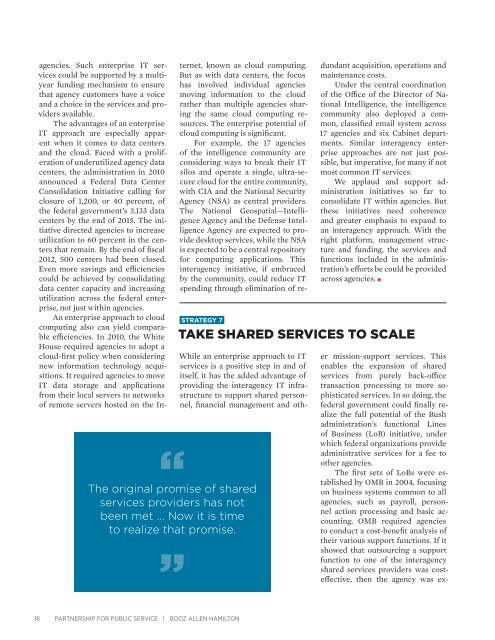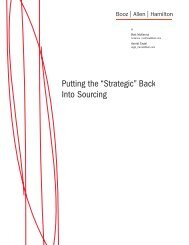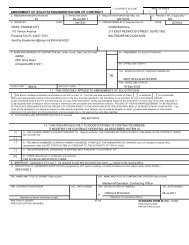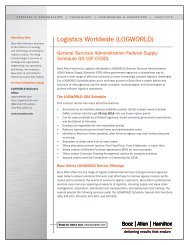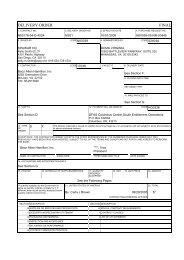agencies. Such enterprise IT servicescould be supported by a multiyearfunding mechanism to ensurethat agency customers have a voiceand a choice in <strong>the</strong> services and providersavailable.The advantages of an enterpriseIT approach are especially apparentwhen it comes to data centersand <strong>the</strong> cloud. Faced with a proliferationof underutilized agency datacenters, <strong>the</strong> administration in 2010announced a Federal Data CenterConsolidation Initiative calling forclosure of 1,200, or 40 percent, of<strong>the</strong> federal government’s 3,133 datacenters by <strong>the</strong> end of 2015. The initiativedirected agencies to increaseutilization to 60 percent in <strong>the</strong> centersthat remain. By <strong>the</strong> end of fiscal2012, 500 centers had been closed.Even more savings and efficienciescould be achieved by consolidatingdata center capacity and increasingutilization across <strong>the</strong> federal enterprise,not just within agencies.An enterprise approach to cloudcomputing also can yield comparableefficiencies. In 2010, <strong>the</strong> WhiteHouse required agencies to adopt acloud-first policy when consideringnew information technology acquisitions.It required agencies to moveIT data storage and applicationsfrom <strong>the</strong>ir local servers to networksof remote servers hosted on <strong>the</strong> Internet,known as cloud computing.But as with data centers, <strong>the</strong> focushas involved individual agenciesmoving information to <strong>the</strong> cloudra<strong>the</strong>r than multiple agencies sharing<strong>the</strong> same cloud computing resources.The enterprise potential ofcloud computing is significant.For example, <strong>the</strong> 17 agenciesof <strong>the</strong> intelligence community areconsidering ways to break <strong>the</strong>ir ITsilos and operate a single, ultra-securecloud for <strong>the</strong> entire community,with CIA and <strong>the</strong> National SecurityAgency (NSA) as central providers.The National Geospatial—IntelligenceAgency and <strong>the</strong> Defense IntelligenceAgency are expected to providedesktop services, while <strong>the</strong> NSAis expected to be a central repositoryfor computing applications. Thisinteragency initiative, if embracedby <strong>the</strong> community, could reduce ITspending through elimination of redundantacquisition, operations andmaintenance costs.Under <strong>the</strong> central coordinationof <strong>the</strong> Office of <strong>the</strong> Director of NationalIntelligence, <strong>the</strong> intelligencecommunity also deployed a common,classified email system across17 agencies and six Cabinet departments.Similar interagency enterpriseapproaches are not just possible,but imperative, for many if notmost common IT services.We applaud and support administrationinitiatives so far toconsolidate IT within agencies. But<strong>the</strong>se initiatives need coherenceand greater emphasis to expand toan interagency approach. With <strong>the</strong>right platform, management structureand funding, <strong>the</strong> services andfunctions included in <strong>the</strong> administration’sefforts be could be providedacross agencies. •STRATEGY 7TAKE SHARED SERVICES TO SCALE“The original promise of sharedservices providers has notbeen met … Now it is timeto realize that promise.”While an enterprise approach to ITservices is a positive step in and ofitself, it has <strong>the</strong> added advantage ofproviding <strong>the</strong> interagency IT infrastructureto support shared personnel,financial management and o<strong>the</strong>rmission-support services. Thisenables <strong>the</strong> expansion of sharedservices from purely back-officetransaction processing to more sophisticatedservices. In so doing, <strong>the</strong>federal government could finally realize<strong>the</strong> full potential of <strong>the</strong> Bushadministration’s functional Linesof Business (LoB) initiative, underwhich federal organizations provideadministrative services for a fee too<strong>the</strong>r agencies.The first sets of LoBs were establishedby OMB in 2004, focusingon business systems common to allagencies, such as payroll, personnelaction processing and basic accounting.OMB required agenciesto conduct a cost-benefit analysis of<strong>the</strong>ir various support functions. If itshowed that outsourcing a supportfunction to one of <strong>the</strong> interagencyshared services providers was costeffective,<strong>the</strong>n <strong>the</strong> agency was ex-18 PARTNERSHIP FOR PUBLIC SERVICE | BOOZ ALLEN HAMILTON
pected to take that step. 8By 2009, almost all federalpayroll services were consolidatedamong four government-wideshared services providers, and OPMnamed five interagency providersfor personnel services. Today OMBapprovedinteragency shared servicesproviders include <strong>the</strong> InteriorDepartment’s Business Center, <strong>the</strong>Agriculture Department’s NationalFinance Center and seven o<strong>the</strong>rs.These providers offer shared servicesfor budget formulation andexecution, geospatial data, informationsystems security and financialand grants management, in additionto personnel and payroll services.For <strong>the</strong> most part, LoB sharedservices providers have focused onleveraging common business systemssuch as human resources andfinancial management to provideinteragency customers with back-officeand transaction-processing support.This includes such core administrativeservices as cutting payrollchecks and processing promotionactions, posting debits and creditsto an agency’s operating ledger andtracking procurement contracts.The original promise of sharedservices providers has not been met.The vision was that <strong>the</strong>y would assumeeven more of <strong>the</strong> government’scommon administrative workload,including labor-intensive functionssuch as <strong>the</strong> interaction between amanager and a personnel specialistbefore a promotion decision is madeand processed. Now it is time to realizethat promise.Additional enterprise efficienciesare possible. For example, <strong>the</strong>Air Force has consolidated many ofits personnel support services foractive-duty and reserve militarymembers as well as civilian employees,using a sophisticated combinationof online self-service applica-8 CIO Council, Federal Shared Services ImplementationGuide (Washington, DC, April 16,2013).tions, automated voice-responsesystems and live personnel specialiststo provide near full-time coveragefor <strong>the</strong> department’s worldwideforce of nearly 500,000.The Internal Revenue Service’sAgency Wide Shared Services organizationprovides similar consolidatedpersonnel services, such as staffing,labor and employee relations, forits nationally deployed workforce ofmore than 100,000. If such servicescan be provided on this scale withincomplex, diverse and geographicallydispersed agencies, <strong>the</strong>y can be providedas an enterprise portfolio to allagencies.The DOD’s more than three millionmilitary and civilian personnelare paid through a single integratedpayroll system. Its 800,000 civiliansare covered by a single humanresources information system. 9 Yetcivilian employees still are servedby more than 100 separate personneloffices, each providing similarservices under almost <strong>the</strong> same personnelrules using a common humanresources information system.This situation is ripe for consolidation.And <strong>the</strong> Pentagon could offer<strong>the</strong> service on an enterprise basis too<strong>the</strong>r agencies.The o<strong>the</strong>r HR shared servicesproviders, such as <strong>the</strong> Treasury Departmentand <strong>the</strong> National FinanceCenter, can and should follow thissame path. They already providetransaction-level support to multipleagencies and could build uponthat success to offer additional personnelservices to <strong>the</strong>ir interagencycustomers at significant savings,such as drafting job applications.Personnel services are not <strong>the</strong>only area ripe for an enterprise ap-9 Department of Defense, Fiscal 2013 BudgetEstimates, Defense Human Resources Activity(Washington, D.C., Feb. 2012), http://comptroller.defense.gov/defbudget/fy2013/budget_justification/pdfs/01_Operation_and_Maintenance/O_M_VOL_1_PARTS/O_M_VOL_1_BASE_PARTS/DHRA_OP-5.pdf. Lastaccessed Jul. 26, 2013.proach. The Obama administrationhas issued a shared-first policy forfinancial services information technologysystems. On March 25, 2013,former OMB Comptroller DannyWerfel directed all agencies to useone of <strong>the</strong> approved shared servicesfinancial management providers tomodernize <strong>the</strong>ir core accountingsystems.According to Werfel, “<strong>the</strong> cost,quality and performance of federalfinancial systems can be improved byfocusing government resources onfewer, more standardized solutionsthat are implemented and operatedby more experienced staff.” Sharedservices provided using standardizedfinancial systems will reduce<strong>the</strong> risks of large, lengthy financialmanagement system implementationsand make federal financesmore accurate and more transparent,Werfel said. OMB also plans toensure that financial shared servicescenters use common standards andrequirements so agencies retain<strong>the</strong> flexibility to migrate amongproviders.This is exactly <strong>the</strong> sort of enterpriseapproach to shared servicesthat is needed—leveraging commonfunctional requirements, businesssystems and IT infrastructure toprovide mission support in multipleagencies. Indeed, <strong>the</strong>se effortsshould be expanded under <strong>the</strong> auspicesof an enterprise goal leaderfor each of <strong>the</strong> LoB portfolios, withthose goal leaders charged to take<strong>the</strong>m to <strong>the</strong> next level of enterpriseefficiency and effectiveness. •BUILDING THE ENTERPRISE 19


